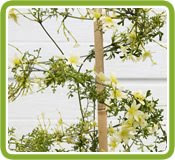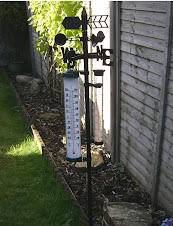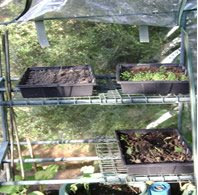
Phase 2 of the Spiraclimb Garden occurred this weekend thanks to some great weather and an unaccountable surge of energy on my part! Maybe it was the sugar in the donuts I ate or something but in any case, about 3/4 of the plot has now been cleared.
The Spiraclimb garden used, as far as I can tell, to be a vegetable plot tucked away in a forgotten corner of the main garden. It has long since fallen into disuse and had completely overgrown with grasses, brambles, ferns and saplings from the nearby hazel tree. It was also completely covered in bluebells.
Unfortunately, the species of bluebell is Spanish, which is an attractive but aggressive species that is steadily driving out the native variety. I have heavily culled the bulb stock, therefore, transferring a few to pots where they can do no harm. Given the numbers involved, though, I very much doubt that the plot will be entirely free of bluebells!
My initial task has been to clear the plot of overgrowth and aggressive weeds and also to level off the plot for fresh planting. In the past it appears a large tree or shrub was dug out and so the plot has a crater in the middle which, once cleared of overgrowth, will need to be leveled.
Progress so far:
- uncover the path to the garden,
- clear overgrowth from the Cornish stone wall along one side,
- discover/define the edges of the plot (turned out to be a raised bed)
- Set up two mini greenhouses for seeds/young plants
- begin clearing the main bed of overgrowth
- save & transplant some plants from the bed into pots
The idea of the Spiraclimb Garden, aside from giving me a garden space I can enjoy, will be to experiment with using Spiraclimb in the actual beds to bring height and allow for the support of climbers within the garden.
My initial plan is to plant out a crop of
Spiraclimb runner beans, if the slugs can be kept at bay. After the first seeds failed to germinate (my mistake - used old seeds!) I replanted and the new crop are just about sprouting now.
For the record, although I am not 100% organic in my approach I have sourced slug pellets that meet organic standards and are not harmful to pets, birds or hedgehogs. They also quickly degrade into the soil. You can get additional tips on
growing runner beans with Spiraclimb on the
Spiraclimb website.
 Last month was an exciting one for Spiraclimb as we made our first delivery since becoming approved suppliers for the National Trust. This means that hopefully in 2010, Spiraclimb will be much more widely available through their national chain of plant shops.
Last month was an exciting one for Spiraclimb as we made our first delivery since becoming approved suppliers for the National Trust. This means that hopefully in 2010, Spiraclimb will be much more widely available through their national chain of plant shops.



















